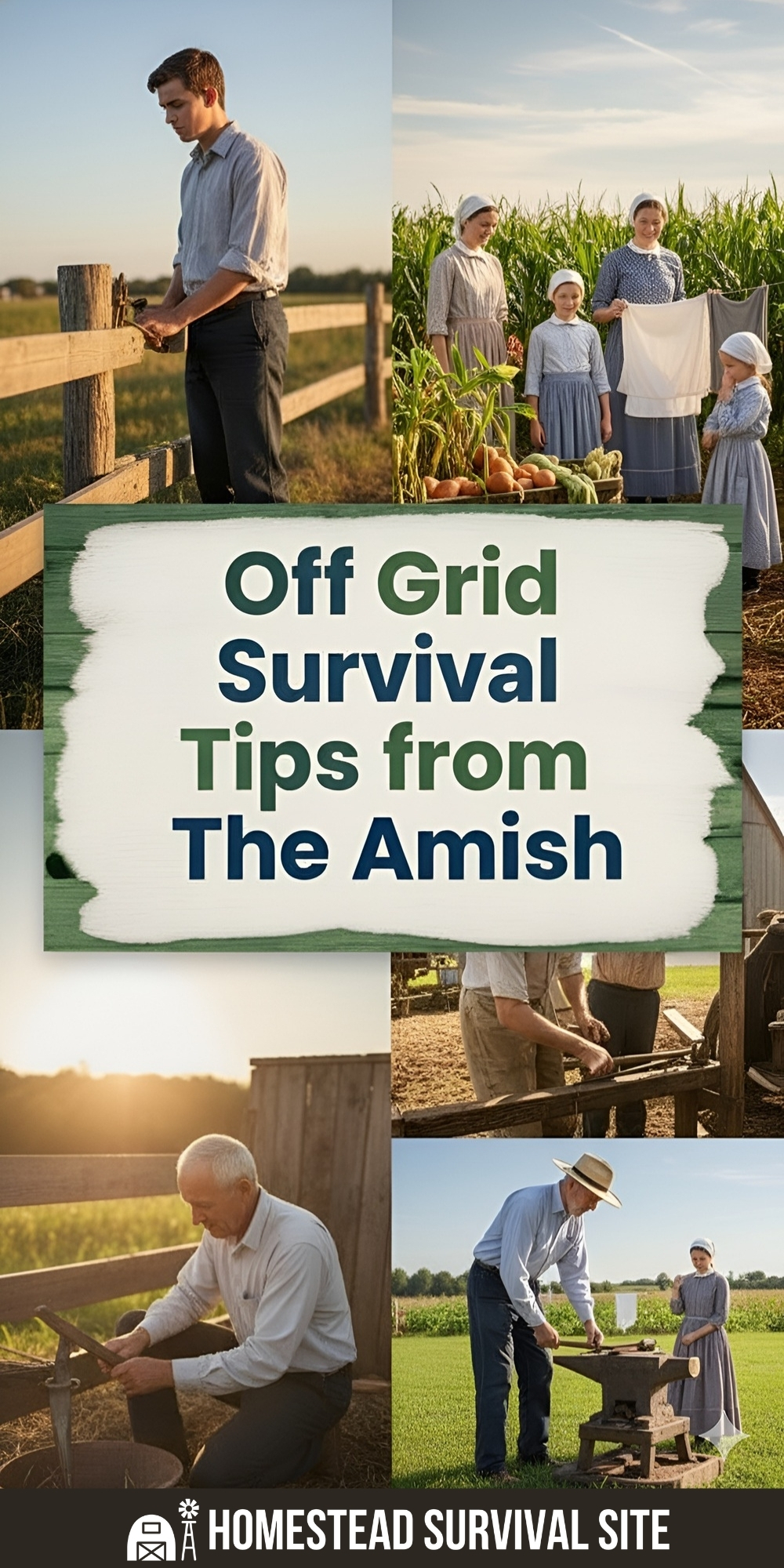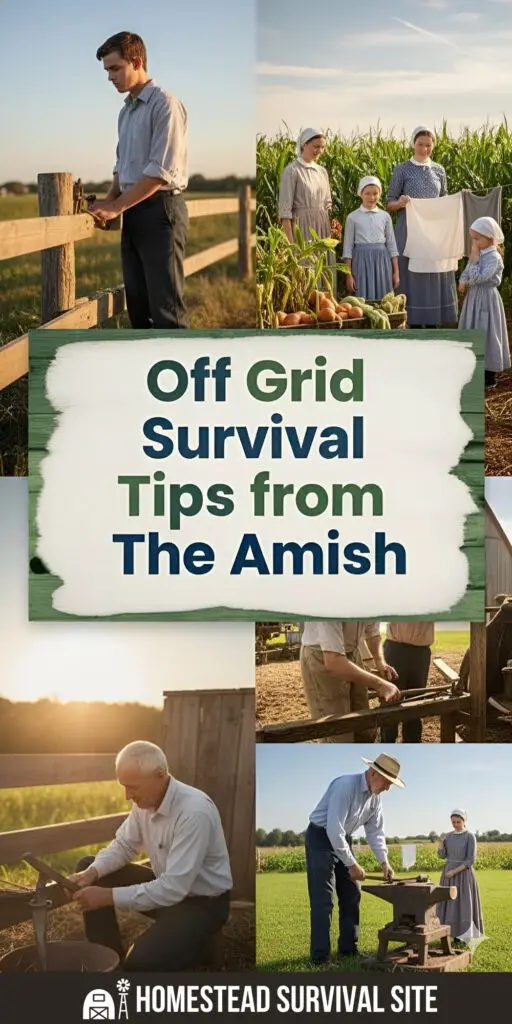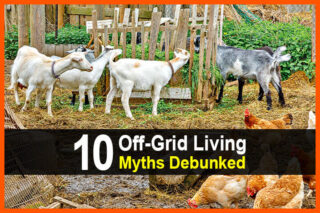Estimated reading time: 12 minutes
The Amish first arrived in the United States in the mid 1700’s. Of course it was still a British colony at the time but since that time the Amish population in the U.S. has grown to almost 300,000. They live in communities across the country and are known for their firm commitment to a simpler, pioneer lifestyle.
Contrary to some assumptions, the Amish do not shun all technology. They have been known to use diesel powered generators, propane powered refrigerators and freezers, and commonly use solar, wind and water power. The only issues they have with technology are when it is interconnected.
The Amish believe that to retain their independence and freedom from the temptations and evil of modern society, they must avoid those technologies that connect to society in general. This would include the power grid, Internet, broadcast TV and radio signals, and any other technology that is part of a network or system connected to the general public.
Want to save this post for later? Click Here to Pin It On Pinterest!
The Off-Grid Pioneers
As a result, the Amish have been pursuing an off-grid lifestyle for more than 500 years. And while there was no such thing as a power-grid 500 years ago, there were still networks of connection that they avoided. They have occasionally if not reluctantly accepted some forms of technology, but it usually requires approval from the local Amish community. This approval varies from community to community.
One surprising example is that some Amish farmers have wireless mobile phones. They don’t usually access the Internet nor do many of the other things most of us do, but many Amish are in business to sell products they produce and need some way to connect to stores and suppliers.
In spite of their occasional use of cell phones they still don’t have hard line phones in their homes. That would be “too connected” to the outside world.
Centuries of Preparedness
As much as some of us worry about a massive grid failure, water shortages and cyberattacks on the Internet, the Amish have been calmly living a prepared life as a matter of course and a matter of choice. There are lessons to be learned here and they go beyond skills and hand tools to a mindset and a state of mind.
A Life Defined by Self-Reliance
It would be a stretch to believe that the Amish never go to a store, but it’s a rare occurrence and their shopping is both specific and limited. One store that has both a catalog and an online presence is Lehman’s. They sell a line of products uniquely tailored to the Amish lifestyle and work style. This includes many of the hand-powered tools and equipment that is no longer made, or only found in antique stores and flea markets.
Just about everything else they need they either grow, make, build or barter for. It’s a lifestyle motivated by a daily commitment to self-reliance and the discipline to make that happen.
One of their mindsets is the fact that every day is a to-do list of chores; some routine, some seasonal, and others necessary or pursued. Kids are often involved in the daily chores both as a means of learning self-reliant skills, and as a necessary set of extra helping hands. To the Amish, hard work is both noble and expected.
They dress very traditionally and their fashion choices haven’t changed for more than 100 years. Their clothes are usually handmade, their food is homegrown, and everything is home cooked, canned or preserved.
We’re going to step back and look at the various actions, skills and behaviors of a typical Amish community to identify some of those actions, skills and behaviors we could and maybe should adopt for our own self-reliance and independence.
The Basic Skills
To begin, the Amish are predominantly farmers. They chose farming because it allowed them to not only live independently but to locate in rural areas away from the sins and opinions of the city.
√ Farming
This isn’t about farming in the traditional sense. Few Amish actively grow, harvest and sell large quantities of a single crop to sell on the open market.
Most of their farming activity is focused on growing their own food to eat, growing some to sell either at their own farm stand or to local grocers, and food as barter for other goods and services they might need within the Amish community and the local community at large.
Mechanical, motor driven equipment is rarely used and instead horses are the literal horsepower of choice.
It’s rare that you would see a gas powered roto-tiller, but some Amish have used diesel powered hay bailers and other diesel-powered equipment for tasks that are either too difficult or too dangerous to do by hand.
Every aspect of farming and gardening is mostly done by hand from tilling to planting, harvesting and storing. Horse-drawn wagons and equipment pull the heavy loads but tasks that can be done by hand are done by hand.
The Amish always harvest seeds from every crop and store them for the next season. They compost everything from weeds to straw to table scraps to manure and chicken droppings.
√ Building
The Amish are master builders. They are known for their carpentry skills and their handmade furniture is highly regarded. They are also masters of timber frame construction and work together in their community to raise barns, sheds and homes for their families and neighbors.
Many are accomplished masons and their sturdy brick walls have rolled across the hills and valleys of their farms for centuries. From barn foundations to bricking a water well; masonry and the ability to use stone, mortar and masonry tools are second to only carpentry in their wheelhouse of skills.
√ Harnessing Water
Many Amish farms and properties feature water wheels powered by creeks and streams to grind flower, pump water to their homes and to irrigate their farms, and even to power saw mills and timber pulleys.
They are accomplished at digging wells and their use of hand pumps to pump water is not only common but expected. They are expert at collecting rainwater and harvesting water from lakes, ponds and streams.
They are accomplished at crafting water filters from gravel, sand and charcoal and heat their water with wood-fired cook stoves with a reservoir attached. They also heat water with rooftop solar water heaters and sometimes simply heat the water in a large stockpot over an open fire.
√ Harnessing Wind
Few Amish farms are without their share of windmills. They’re used to do everything from pumping water to generating electricity. Long before wind-power became a buzzword for green energy, farmers like the Amish were harnessing the wind.
The wind was also used to dry the laundry and of course separate the wheat from the chaff. Windmills also powered small grain mills and even small water pumps to direct water to a livestock trough or small garden.
If there was a force of nature that could provide power to accomplish a task, the Amish harnessed it and put it to good use.
√ Preserving Foods
Food preservation was another primary skill pursued by the Amish. Canning was a regular activity and their pantries and root cellars were always filed with the results of their canning efforts.
They were also expert at curing and smoking meats and a smokehouse was a common and often necessary addition to any Amish farm. The smokehouse was used to both smoke the cured meats and to store them over time.
Dehydrating foods and vegetables using the sun was another common Amish practice. From raisins to sun-dried tomatoes, if it could be sun-dried it found its place in the Amish sun.
Just as many foods were fermented and given the German origins of some Amish communities, sauerkraut was often found in every Amish pantry.
√ Animal Husbandry
Amish livestock went well beyond the standard flock of chickens. Horses had a constant and necessary presence in every Amish barn. Cows were raised for their milk and other dairy products. Pigs, goats and sheep were also on the farm. And of course, there were always chickens.
√ Off-Grid Heating
Wood burning stoves were a standard addition to an Amish farmhouse and chopping wood was a daily chore. Most homes also had fireplaces both for heat and cooking.
Many Amish farms also had “summer kitchens.” These were dedicated structures removed from the main house where wood-fired stoves could be used for daily cooking without making the heat unbearable in the main house in summer.
√ Off-Grid Cooking
Wood burning cook stoves were the primary centerpiece in any Amish kitchen and they not only provided additional heat in winter, but were used to cook everything.
The Amish also cooked outside whether they were roasting whole hogs, chickens on a spit or boiling down tree sap for syrup.
√ Off-Grid Cooling
Many pioneers and native people across North America used innovative ways to keep cool in summer. The Amish kept cool using many of those traditional techniques from well designed venting to the use of cold traps.
Basements and root cellars were always a cool location and the Amish were also mindful about keeping their animals cool.
Foods were kept cool in root cellars, basements, and with modern conveniences like propane powered refrigerator/freezers.
Ice was often harvested from ponds and lakes in winter and dedicated ice-houses were used for year-round cold storage of foods. They also were quick to use ice-boxes in their kitchens and have even been known to use old electric refrigerators without electricity to both contain the ice for cooling, and to take advantage of the insulation properties of any refrigerator.
√ Alternative Power
Off-grid doesn’t mean the electricity is always off to the Amish. It means they are not connected to a networked power grid, but they still find ways today to generate electricity.
Solar power is both used and embraced by many Amish communities as an independent source of power. One reference to the use of solar power by the Amish referred to it as connecting to “God’s-grid.”
The solar panels are sometimes hooked to a solar generator, and rooftop solar setups even heat water for use in the Amish household.
Windmills to generate power are also embraced, and if a stream or creek is running through their property both ram pumps for pumping water, and water wheels for power generation are quick to appear.
Much of the electricity generated is used to power wood working tools like planers, saws and other workshop tools. The power is also used to generate electricity for basic lighting and appliances.
√ Let There be Light
Lighting options for the Amish are wide-ranging from oil filled hurricane lamps to kerosene lanterns, candles and candle lanterns, and even LED flashlights and lamps powered by solar rechargeable batteries. Hand-cranked flashlights are another option.
Some of it sounds like technology the Amish would shun and some Amish communities would agree. On the other hand, they are embraced by other Amish communities given the fact that these off-grid lighting options are independent of the grid.
√ Transportation
A horse and carriage are the traditional mode of transportation for the Amish. But they also use bicycles often with an attached buggy-cart, and some of the younger Amish generation has been spotted on roller skates and skateboard scooters.
Whenever long distance travel is required the Amish usually arrange for someone else to drive them to their destination. They won’t own or drive a traditional car, van or truck but when necessary will accept the need to travel as a passenger.
√ First Aid & Herbal Medicine
It’s rare for the Amish to visit a doctor or hospital with any frequency, although they will not hesitate in a desperate emergency. In many instances, the Amish turn to herbal medicine and natural treatments for their ailments.
The Amish are generally in very good health due to the amount of their strenuous physical activity and their essentially organic diet of farm raised foods. They also shun alcohol, tobacco and the other excesses of society that often lead to health issues.
There are books about Amish natural remedies and many of their herbal treatments that have been used and improved over hundreds of years.
√ Crafts
Some of us think of crafts as a hobby. To the Amish, crafts are a way of life. In a social group that typically avoids the commercial offerings of modern society the ability to do-it-yourself is both necessary and expected. Here are just a few of the craft skills the Amish have both mastered and pursue on a regular basis:
- Furniture making
- Quilting
- Candle making
- Soap making
- Pottery
- Beekeeping
- Maple sugaring
- Cider making
- Cider Vinegar
- Sewing
- Knitting and crochet
There’s more and if there’s something that needs to be made by hand it’s a good bet the Amish are making it.
√ Home Schooling
It didn’t take a pandemic to motivate the Amish to home-school their children.
It’s totally consistent with their philosophy and the fear that outside and corrupt influences will affect their children and their community.
Traditionally, the Amish home-schooled their children up through 8th grade. At that point, some shifted their children’s education to mastery of a specific trade as a source of future income and security.
√ Self-Reliant Trades
The trades taught to Amish children started much like all trades are acquired. It started with an apprenticeship usually guided by an expert in the community. The product of their trades were then used to either generate income; used as barter or to supply the immediate family with necessary goods and skills.
These dedicated trade skills were in addition to the previously mentioned craft skills that were seen as expected and common knowledge. The trades that the Amish are known for include:
- Carpentry
- Masonry
- Blacksmithing
- Food Preservation
- Farming and Gardening
- Wheelwright
- Cobbling
- Barrel Cooper
√ Foraging
In addition to farming and animal husbandry, the Amish are expert at wild foraging. Their ability to recognize trees, wild berries, wild mushrooms and other edible wild plants not only supplemented their farming efforts, but provided additional nutrition beyond conventional vegetables and fruits.
√ Barter
Traditional commerce was often a challenge for the Amish. As a community that actively avoided the outside world, the idea of a traditional job with a paycheck was not always a viable possibility. As a result, barter was a very important part of Amish commerce and trade.
The barter items ranged from eggs to fruits and vegetables and even meat and dairy products. They also bartered their crafts from handmade furniture to anything else they could craft or make.
In addition, the Amish bartered their skills for goods and services both within their community and the surrounding local community as well.
√ Acquiring an Amish Mindset
Beyond the skills, crafts and creations generated by Amish communities is a mindset worth considering.
- It begins with a dedication to self-reliance.
- It’s built on a work-ethic that embraces and respects hard work.
- It’s fueled by an independent spirit.
- It is fortified by a community designed around cooperation and sharing.
- It’s dedicated to a commitment to preparedness.
- It’s very accomplished at meeting the challenges of living off-grid.
Anyone with a mindset towards preparedness and self-reliance would be well-served by some of the behaviors and lessons from the Amish communities. It’s gotten them through the last 500 years, and there’s no reason to believe it won’t take them well into the next millennium.
Like this post? Don't Forget to Pin It On Pinterest!
You May Also Like:














Don’t mimic them too much. I like this article, and I extremely appreciate their way of life but those poor families are coming under attack by the American gestapo. Feds taking their livestock, land, and worse. If you privately intimate then that’s great but don’t let your nosy neighbors find out. You don’t know who to trust. But always powder dry, defend your freedom. Some are attacking the Amish in the name of all that’s good. Sad day in this un-united states.
It strikes me that all Americans need some poor small and different group of people to belittle and in timidate
It seems to be in their nature.